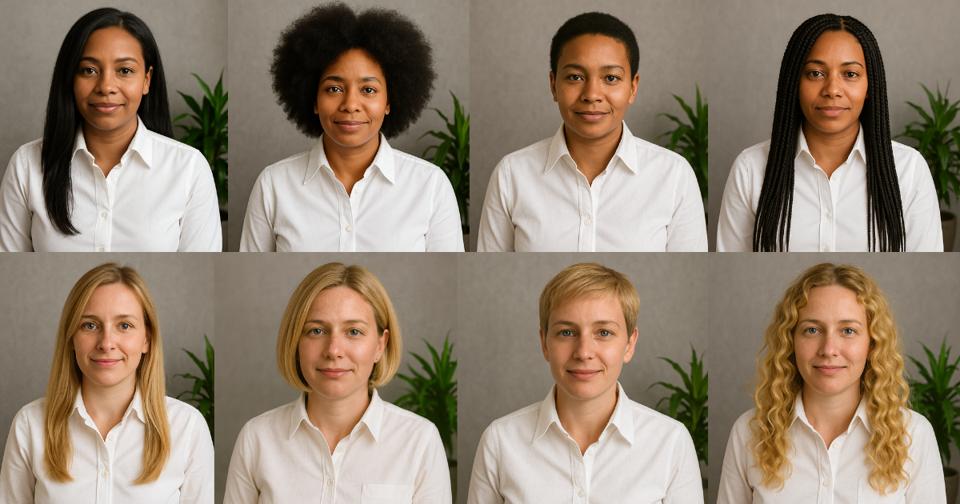An August 2025 experiment highlights the disparities in how AI evaluates Black women’s hairstyles. For the experiment, eight photos were generated by ChatGPT’s image generator DALL-E. Four of the photos were of a Black woman in her late 30s wearing a white button-up shirt. The only variable that was manipulated was the Black woman’s hairstyle and included four different hairstyles: straight shoulder-length hair, a big afro, a teeny-weeny afro (TWA), and braids. A second set of four photos of a white woman in her late 30s wearing the same white button-up shirt were generated, with her hairstyle being the only variable that was manipulated and included four different hairstyles: shoulder-length straight hair, a short pixie cut, a bob style, and long, curly hair. There was a total of eight photos that were put into three different AI systems to assess AI’s perceptions of the individual.
Two of the three AI tools assessed, Clarifai and Amazon Rekognition’s AI, produced similar results. Out of the four different Black woman’s hairstyles that were analyzed, the braids were the only hairstyle that the two AI tools did not assign the characteristic of intelligence to. The braid hairstyle resulted in lower happiness ratings and more neutral emotional ratings compared to the straight hairstyle and the big afro hairstyle. What was also interesting was that with some of the Black women’s hairstyles when comparing them to each other, the AI struggled to recognize them as the same person.
The third AI tool used, Anthropic’s Claude, rated the braid hairstyle more positively and gave the TWA the highest intelligence rating compared to the three other Black woman’s hairstyles. Across all three AI tools, the Black woman with straight hair received the highest professionalism ratings. When assessing AI’s analysis of the white woman’s hairstyles, across the three AI tools, none of the hairstyles were associated with intelligence-related penalties or negative social trait associations and the AI was able to recognize them as the same person, except when the long straight hairstyle was compared to the bob hairstyle—the AI struggled to recognize these as the same person. For the white woman, the long curly hair received lower ratings from the AI than the other three hairstyles it was compared to. This experiment demonstrated that, in general, a white woman’s hairstyle is less likely to affect how AI tools perceive her competence.
There are some important implications of this experiment. There is an increasing amount of workplaces that are now leaning on AI tools like facial recognition and facial analysis software to help them verify the identity of job candidates during the interview process, given the rise in fake candidates applying for remote jobs. When these tools are used, it’s possible that for Black women who change their hairstyle, the AI systems may not be able to verify their identity, leading to an automatic rejection and preventing them from moving to the next stage of the interview process. For Black women who are part of workplaces that adopt facial recognition and facial analysis technology for access to workplace tools or even company buildings, this could cause them heightened scrutiny, denied entry, delays in verification and possibly being locked out of workplace systems.
For workplaces that use AI-powered video analysis tools to assess job candidates, it’s possible that AI tools may flag Black women job candidates as less professional or less intelligent, and they may receive lower ratings and evaluations simply because of their hairstyle. Many Black women feel the pressure to conform, assimilate and change their hairstyle to adhere to Eurocentric standards of beauty and understandably so. Failing to adhere to dominant cultural norms could cost them a job.
AI is just reflecting biases that are entrenched within society but there are several ways for each of us to push back. Education is imperative; everyone should understand hair discrimination and texturism, and how they manifest both within society and in the workplace. Individuals should also learn about the CROWN Act and ensure that workplace policies and practices (particularly grooming and appearance policies) are inclusive and equitable. During the hiring process, candidates should be evaluated based on objective criteria, rubrics and scorecards should be integrated into the hiring process, and if culture fit is included as a hiring metric, it should be clearly outlined and defined. Lastly, ensure that if you’re utilizing AI to aid with hiring decisions, that AI doesn’t have the final say and that there is human oversight at every step of the way.

